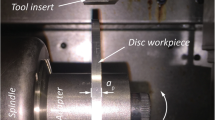Abstract
Chip type is determined by the coupled effects of workpiece material property, cutting speed, uncut chip thickness, feed rate, and tool edge geometry. The understanding of chip formation plays a critical role in studying surface integrity and optimization of machining process variables. Serrated chip, one of the major important chip type, is usually formed in hard cutting at high speed. In this study, a new analytical model has been proposed to better understand the formation of serrated chip, and the simulations have been acquired using ABAQUS/Explicit in machining AISI 1045 during different speeds (from 60 to 6000 m/min). The workpiece material property is modeled with the Johnson-Cook model, and the experiments have been conducted with AISI 1045 during speeds from 60 to 1200 m/min. It has been shown that flow stress is influenced simultaneously by the strain rate hardening and temperature softening. When the speed reaches very high, the temperature softening will fail, and the strain rate hardening will play a more important role. Also, it can be found that the hardening ratio increases when the cutting speed rises. The results of the simulations and experiments correlated well. The cutting force and thrust force both decrease as the cutting speed increases, and the difference between them will shrink when the machining speed reaches a high level.
Similar content being viewed by others
References
Molinari A, Musquar C, Sutter G (2002) Adiabatic shear banding in high speed machining of Ti-6Al-4V: experiments and modeling. Int J Plast 18(4):443–459
Nakayama K, Arai M, Kanda T (1988) Machining characteristics of hard materials. CIRP Ann Manuf Technol 37(1):89–92
Shaw MC, Vyas A (1993) Chip formation in the machining of hardened steel. CIRP Annals - Manuf Technol 42(1):29–33
Su GS, Liu ZQ (2010) An experimental study on influences of material brittleness on chip morphology. Int J Adv Manuf Technol 51:87–92
Hua J, Shivpuri R (2004) Prediction of chip morphology and segmentation during the machining of titanium alloys. J Mater Proc Technol 150(1–2):124–133
Kountanya R, Al-Zkeri I, Altan T (2009) Effect of tool edge geometry and cutting conditions on experimental and simulated chip morphology in orthogonal hard turning of 100Cr6 steel. J Mater Proc Technol 209(11):5068–5076
Recht RF (1964) Catastrophic thermoplastic shear. J Appl Mech 31(2):189–193
Recht RF (1985) A dynamic analysis of high-speed machining. J Manuf Sci Eng 107(4):309–315
Lee D (1985) The effect of cutting speed on chip formation under orthogonal machining. J Manuf Sci Eng 107(1):55–63
Gente A, Hoffmeister HW, Evans CJ (2001) Chip formation in machining ti6al4v at extremely high cutting speeds. CIRP Annals - Manuf Technol 50(1):49–52
Bäker M (2006) Finite element simulation of high-speed cutting forces. J Mater Proc Technol 176(1–3):117–126
Bäker M, Rösler J, Siemers C (2003) The influence of thermal conductivity on segmented chip formation. Comput Mater Sci 26:175–182
Klocke F, Raedt HW, Hoppe S (2001) 2D-FEM simulation of the orthogonal high speed cutting process. Mach Sci Technol 5(3):323–340
Rhim SH, Oh SI (2006) Prediction of serrated chip formation in metal cutting process with new flow stress model for AISI 1045 steel. J Mater Proc Technol 171(3):417–422
Johnson GR, Cook WH (1985) Fracture characteristics of three metals subjected to various strains, strain rates, temperatures and pressures. Eng Fract Mech 21(1):31–48
Wang B, Liu ZQ (2014) Investigations on the chip formation mechanism and shear localization sensitivity of high-speed machining Ti6Al4V. Int J Adv Manuf Technol 75:1065– 1076
Chen G, Ren CZ, Yang XY, Jin XM, Guo T (2011) Finite element simulation of high-speed machining of titanium alloy (Ti-6Al-4V) based on ductile failure model. Int J Adv Manuf Technol 56:1027–1038
He N, Lee TC, Lau WS, Chan SK (2002) Assessment of deformation of a shear localized chip in high speed machining. J Mater Proc Technol 129(1–3):101–104
Aurich JC, Bil H (2006) 3D finite element modelling of segmented chip formation. CIRP Ann Manuf Technol 55(1):47–50
Su GS, Liu ZQ, Du J, Yang QB (2010) Description of serrated chip deformation and its morphology evolution. Transactions of the Chinese Society for Agriculture Machinery 41(11):223–227
Barry J, Byrne G (2002) Chip formation, acoustic emission and surface white layers in hard machining. CIRP Ann Manuf Technol 51(1):65–70
Duan CZ, Zhang LC (2013) A reliable method for predicting serrated chip formation in high-speed cutting: analysis and experimental verification. Int J Adv Manuf Technol 64(9–12):1587–1597
Alvarez R, Domingo R, Sebastian MA (2011) The formation of saw toothed chip in a titanium alloy: influence of constitutive models. Strojniski vestnik - J Mech Eng 57(10):739–749
Liu K, Melkote SN (2007) Finite element analysis of the influence of tool edge radius on size effect in orthogonal micro-cutting process. Int J Mech Sci 49(5):650–660
Author information
Authors and Affiliations
Corresponding author
Rights and permissions
About this article
Cite this article
Wan, L., Wang, D. & Gao, Y. The investigation of mechanism of serrated chip formation under different cutting speeds. Int J Adv Manuf Technol 82, 951–959 (2016). https://doi.org/10.1007/s00170-015-7409-3
Received:
Accepted:
Published:
Issue Date:
DOI: https://doi.org/10.1007/s00170-015-7409-3



